 |
 |
|
 |
|
 |
|  |
|  |
|
 |
From: William F Pokorny
Subject: Re: Old media blob issue leading to a look at sturm / polysolve.
Date: 27 Apr 2018 09:25:43
Message: <5ae324d7$1@news.povray.org>
|
|
 |
|  |
|  |
|
 |
On 04/26/2018 10:16 AM, Bald Eagle wrote:
> William F Pokorny <ano### [at] anonymous org> wrote:
>
...
>
> Just for clarification, POV-Ray uses:
> bisection
> regula falsa
> Newton's method, and
> the Sturmian method
> ?
> Or are some of those the same?
>
> and - where is this all located in the source code?
> Because I'm a hopeless intellectual masochist like that.
>
Thanks. Suppose I've been exposed to some of the concepts in the past,
but trust me, I'm climbing the learning curve/mountain(a) with this
stuff. There is much I don't understand. My standard set of test scenes
number a 195 at present which have corrected many of my missteps.
You can find most of the code in source/core/math/polynomialsolver.cpp.
There are three custom solvers in solve_quadratic(), solve_cubic() and
solve_quartic() for orders 2 through 4. I've hardly looked at these.
In polysolve / 'sturm' - a sturm chain based bisection method is used in
combination with regula_falsa(). Value based bisection isn't used at
in the sturm chain are, in my present version, the original and it's
normalized derivative. Who knows, might play with it as an alternative
or adjunct to regula_falsa(). The spin is it's really fast when it works
- but sometimes it doesn't.
Near term looking more at the missing root issue - some(b) of which was
addressed with (9), but the rest comes to the roots having collapsed
toward each other so severely the sturm chain root counting / isolation
falls apart. Not looking like it will be easy to mitigate...
Bill P.
(a) - Trying to get out of the media whirlpool! :-)
(b) - Where the sturm chain root counting and isolation stuff still
works despite how close the roots are. org> wrote:
>
...
>
> Just for clarification, POV-Ray uses:
> bisection
> regula falsa
> Newton's method, and
> the Sturmian method
> ?
> Or are some of those the same?
>
> and - where is this all located in the source code?
> Because I'm a hopeless intellectual masochist like that.
>
Thanks. Suppose I've been exposed to some of the concepts in the past,
but trust me, I'm climbing the learning curve/mountain(a) with this
stuff. There is much I don't understand. My standard set of test scenes
number a 195 at present which have corrected many of my missteps.
You can find most of the code in source/core/math/polynomialsolver.cpp.
There are three custom solvers in solve_quadratic(), solve_cubic() and
solve_quartic() for orders 2 through 4. I've hardly looked at these.
In polysolve / 'sturm' - a sturm chain based bisection method is used in
combination with regula_falsa(). Value based bisection isn't used at
in the sturm chain are, in my present version, the original and it's
normalized derivative. Who knows, might play with it as an alternative
or adjunct to regula_falsa(). The spin is it's really fast when it works
- but sometimes it doesn't.
Near term looking more at the missing root issue - some(b) of which was
addressed with (9), but the rest comes to the roots having collapsed
toward each other so severely the sturm chain root counting / isolation
falls apart. Not looking like it will be easy to mitigate...
Bill P.
(a) - Trying to get out of the media whirlpool! :-)
(b) - Where the sturm chain root counting and isolation stuff still
works despite how close the roots are.
Post a reply to this message
|
 |
|  |
|  |
|
 |
From: William F Pokorny
Subject: Re: Old media blob issue leading to a look at sturm / polysolve.
Date: 29 Apr 2018 16:52:54
Message: <5ae630a6$1@news.povray.org>
|
|
 |
|  |
|  |
|
 |
On 03/30/2018 08:21 AM, William F Pokorny wrote:
>
...
> Bill P.
While studying the missing root problem I finished off some initial
lower and upper root bound estimation code aimed at polysolve()
performance. The update is at:
https://github.com/wfpokorny/povray/tree/fix/polynomialsolverAccuracy
The update is directly related to a sub-discussion of issue:
https://github.com/POV-Ray/povray/issues/236
Currently the upper bound method(d) is hard coded to run always. Longer
term, and given I've found some POV-Ray objects such as blob already
calculate a 'max_bounds' value, I'm thinking about a change to the
Solve_Polynomial(), polysolve() calls to add a parameter where :
a) if > 0 value, we'd be passing a known upper bound for all roots.
b) if == 0, we'd do what we do today.
c) if == -1, we'd run the original Cauchy's bound estimate method good
for the lowest value root. In some applications, that first root might
be all we need.
d) if == -2, we'd run an estimator based on Cauchy's method from a 2009
paper(z) found via:
https://en.wikipedia.org/wiki/Properties_of_polynomial_roots#Other_bounds
and good for the upper bound of all roots.
There are better bound estimators, but all I've looked at are more
complex - and several I don't understand. In any case I doubt we'd buy
back the performance given our equation orders are tiny compared to that
aimed at by the more generic solvers for which these better estimator
were created. Many others also use complex numbers.
Bill P.
(z) - Had to tweak it slightly due two sor fails in testing. Due the
surprise with sturm-cubic it's on my list to enable sturm-quadratic in
Solve_Poly() to do some more testing.
Performance info:
------------ /usr/bin/time povray -j -wt1 -fn -p -d -c lemonSturm.pov
0) master 30.22user 0.04system 0:30.89elapsed
9) 687f57b 19.44user 0.01system 0:20.06elapsed -35.67%
10) 0f6afcc 14.77user 0.02system 0:15.36elapsed -24.02% -51.13%
Post a reply to this message
|
 |
|  |
|  |
|
 |
From: William F Pokorny
Subject: Re: Old media blob issue leading to a look at sturm / polysolve.
Date: 8 May 2018 09:11:34
Message: <5af1a206$1@news.povray.org>
|
|
 |
|  |
|  |
|
 |
On 03/30/2018 08:21 AM, William F Pokorny wrote:
>....
Sturm / polysove() investigation. Chapter ??. Corruption of the Sturm Chain.
Let me start this post with the news I found something amiss in the
recent bound estimate code recently added to:
https://github.com/wfpokorny/povray/tree/fix/polynomialsolverAccuracy
despite having run 200 plus scenes and image compares without a difference.
Caught the issue while playing with the idea of trading off the one root
vs all roots method automatically. Not trusting the implementation;
added an auto-bound check for lost roots and an assert and BOOM. So, I
have more to do there even if at worst it's leaving a sanity check in
place that resorts to an upper bound of MAX_DISTANCE. Back to that later.
---
Today let us elsewhere ponder. The function modp() does the bulk of the
sturm chain set up. At the end of modp is this bit of code:
k = v->ord - 1;
while (k >= 0 && fabs(r->coef[k]) < SMALL_ENOUGH)
{
r->coef[k] = 0.0;
k--;
}
r->ord = (k < 0) ? 0 : k;
It individually prunes equations in the sturm chain at a depth of >= 2
where the leading coefficients are small.
In Mr. Enzmann's original 1.0 code, 'SMALL_ENOUGH' was 1e-20. In the
days of single floats likely meant lots of looping and looking while
doing little. As of POV-Ray v3.0 'SMALL_ENOUGH' was drastically
increased to 1e-10.
Over the past week or more I've been looking again at achieving better
accuracy. Tried quite a lot of things finally coding up a __float128
version of polysolve all aiming at more accuracy. Finally realized the
remaining issues are far from all about accuracy. Sometimes the
ray-surface equation coming in is simply messed up with respect to any
sign change based methods for isolating the roots - unless we cheat.
For best accuracy while avoiding spurious roots with ill-formed
equations, the value used should be right at the best accuracy for the
floating point type. This would be 1e-7 for floats, 1e-15 for doubles
and 1e-33 for 128 bit floats. With well behaved equations with no zero,
near zero or cross term zero terms during the creation of the sturm
chain equations can support much smaller minimum values, but in a
raytracer we cannot count on the good behavior of the ray-surface equations.
So, why is that 'SMALL_ENOUGH' value sitting at a much larger 1e-10
value for doubles. My guess is someone understood or stumbled upon a
wonderful bit of serendipity in how the pruning of the sturm chain
equations effectively work. Namely, when we have ill-formed equations
with respect to sign chain based root isolation, the pruning value can
be adjusted upward and by 'magic' some or all of the 'ill' in the
incoming equation is pruned and the root isolation works well enough to
hand the regula-falsi method a problem it can solve.
The downside is you cannot universally set this value above the minimum
for the float size when you have well behaved incoming equations or you
prune off sign change information you need to accurately see the
intervals in which roots exist. We are using a fixed value today.
To better demonstrate attaching two images. In both the left column is
what the current master renders. The remaining columns to the right are
rendered with a float128 version of polysolve to better drive home the
point it our primary need isn't better overall accuracy, but more
accurate root isolation.
In the latheQuadratic.png image the top row is the point set from last
falls lathe issue used in a quadratic spline. The top row is a
perspective camera but zoomed way out and using a camera angle of 2. The
bottom row is the same input except with an orthographic camera set
up(1). In the middle column is what the current patched branch renders
using the SMALL_ENOUGH 1e-10 value. The value has been set so as to
behave well for the orthographic case, but this causes issues for the
perspective case. In the right column SMALL_ENOUGH has been set to
float128's minimum value of 1e-33. This orthographic case falls apart
showing the underlying ill-formed for sign change isolation problem -
while the perspective camera case is OK.
In the sphere_sweeps.png image showing the same progression(2) in
columns 1-3 but in column 4 we dial in a higher SMALL_ENOUGH value which
prunes off just the right about of the sturm chain for the root
isolation to work well.
I'm busy with real life for a while starting later today, but I think we
likely have a path to cleaner renders in these fringe cases given our
sturm chain based method.
We're working in a ray tracer and it is the ray's dx,dy,dz going to zero
which primarily causes the ill-formed for sign base root isolation
issue. We'll need to detect problem directions in the object's code and
create some calculation(3) which we'd pass all the way into the modp()
pruning. Possible I think.
Bill P.
(1) - It's not just the orthographic camera which tends to pull out the
worst case solver issues. Shadow rays with cylindrical and parallel
lights too. There are too the occasional rays which line up orthogonally
in one or compound dimensions.
(2) - Except running with jitter off. Our AA implementations are grid
based which unfortunately tends to line up with the compound (diagonal
type) missing root issues. Thinking something like a Halton sequence
based AA never keeping the center pixel might really help in these cases
by getting the samples more often off the problem ray / surface
grid-axis alignments.
(3) - Perhaps coupled with some ability for users to apply a multiplier
from the SDL?
Post a reply to this message
Attachments:
Download 'lathequadratic.png' (17 KB)
Download 'sphere_sweeps.png' (63 KB)
Preview of image 'lathequadratic.png'
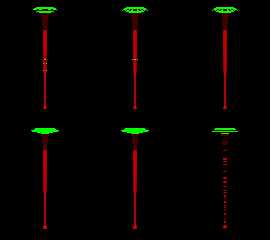
Preview of image 'sphere_sweeps.png'
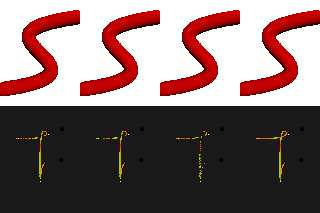
|
 |
|  |
|  |
|
 |
From: William F Pokorny
Subject: Re: Old media blob issue leading to a look at sturm / polysolve.
Date: 18 May 2018 13:00:10
Message: <5aff069a@news.povray.org>
|
|
 |
|  |
|  |
|
 |
On 03/30/2018 08:21 AM, William F Pokorny wrote:
....
Sturm / polysove() investigation. Those Difficult Coefficients.
When we have 4th order equations we are today running this piece of code:
/* Test for difficult coeffs. */
if (difficult_coeffs(4, c))
{
sturm = true;
}
in the Solve_Polynomial wrapper for sturm/polysolve() and three specific
solvers including the one for 4th order equations in solve_quartic().
The difficult_coeffs() function scans the coefficients looking for large
differences in values. If found, user end up running sturm for some rays
no matter what was specified in the scene SDL. The code existed in the
original POV-Ray 1.0, but in a slightly modified form and used with an
older version of solve_quartic().
I've had the feeling for a while the code was probably doing nothing
useful for us today. I was almost completely right. Close enough it's
going into the bit bucket with this set of commits.
The code was set up to crash anytime difficult_coeffs() returned true.
Scanned hundreds of scenes. Turned up helix.pov and a handful of scenes
with blobs. Ran those hard coded to use only solve_quartic() and not a
single difference in result. Changed the code above to return
immediately with no roots on difficult_coeffs() returning true. The
helix scene was unchanged as the 'rays' were not part of the resultant
shape.
The blobs were a different story. Many rays are being re-directed to
sturm / polysolve for no benefit given the current solve_quartic code.
To oblivion with that code you all say!
I thought the same, but remembered we have known blob accuracy issues in
https://github.com/POV-Ray/povray/issues/187, maybe half a dozen related
problem scenes in my test space. Plus to support the subsurface feature
Chrisoph added this bit of code in blob.cpp to avoid visible seams:
DBL depthTolerance = (ray.IsSubsurfaceRay()? 0 : DEPTH_TOLERANCE);
I've been running with DEPTH_TOLERANCE at 1e-4 for a long time in my
personal version of POV-Ray which fixes all the blob accuracy issues
except for the subsurface one.
Given difficult_coeffs() is almost exclusively active with blobs,
updated blob.cpp to run with accuracy addressing the issues in the
previous paragraph. With this update in place, we do occasionally see
cases where the bump into to sturm / polysolve method is necessary.
However, the automatic difficult_coeffs() method doesn't currently catch
all of the fringe case rays.
It could be adjusted so as to push more solve_quartic rays into sturm /
polysolve, but it's aleady the case most difficult-coefficient rays are
unnecessarily run in sturm / polysolve when solve_quartic would work
just fine. The right thing to do is let users decide when to use 'sturm'
and this set of commit dumps the difficult_coeffs() code.
Examples.
The attached image is a scene originally created to explore default
texturing related to negative blobs, but it demonstrates nicely the
issues described above.
In the top row we have on the left the image rendered with the blob
accuracy unmodified and all the difficult_coeffs() code running as it
does today. In the middle image the 'if difficult_coeffs()' test has
been hard coded to return no roots. On the right the difference image
shows all the rays running in the sturm / polysolve method which all run
fine - and faster given the blob set up - with solve_quartic().
In the second row we are running with the new more accurate blob.cpp.
Further, the blobs in the scene have been changed to have a threshold of
0.001 instead of 0.1 - values this low are not common because you don't
get much blobbing.
The first column of the second row was rendered with a version of
POV-Ray compiled to always force the use of solve_quartic(). The middle
column restores the 'if difficult_coeffs()' test and internal swap to
sturm / polysolve. It does help as shown in column 3. However column 2
shows the already too aggressive use of sturm / polysolve with blobs is
not enough to automatically 'fix' all the solve_quartic issues. Running
with sturm is clean in all cases.
Aside: The potentials as glows image I did sometime back had what I
thought were media related speckles. I applied very aggressive and
expensive AA to hide them as I usually do with media. Turns out using
sturm would have been the better choice. I wanted no blobbing for the
blob cylinders and used a threshold of 1e-5. It was a case of outrunning
the effectiveness of the 'if difficult_coeffs() patch' with existing
blob accuracy, but I didn't realize it at the time.
Updates at:
https://github.com/wfpokorny/povray/tree/fix/polynomialsolverAccuracy
Performance and specific commit details below.
Bill P.
Performance info:
------------ /usr/bin/time povray -j -wt1 -fn -p -d -c lemonSturm.pov
0) master 30.22user 0.04system 0:30.89elapsed
10) 0f6afcc 14.77user 0.02system 0:15.36elapsed -51.13%
11) 0f9509b 14.77user 0.01system 0:15.36elapsed
12) c590c0e 15.08user 0.01system 0:15.71elapsed +2.10%
13) 4ab17df 14.88user 0.02system 0:15.51elapsed -1.33% -50.76%
14) 78e664c --- NA ---
15) 5d8cedc --- NA ---
16) 21387e2 --- NA ---
---- povray subsurface.pov -p +wt2 -j -d -c -fn
master sturm on 540.89user 0.06system 4:31.15elapsed
21387e2 sturm on 347.29user 0.07system 2:54.42elapsed -35.79%
master sturm off 286.99user 0.06system 2:24.28elapsed
21387e2 sturm off 278.54user 0.05system 2:20.12elapsed -2.94%
If blob container needs sturm. 278.54 -> 347.29 +24.68%
11) Changing polysolve visible_roots and numchanges zero test to <=0.
Depending upon value used for reducing and trimming the sturm chain
equations in modp, the sphere_sweep b_spline functions can return
negative root counts when there are no roots.
12) Adding sanity test of upper bound Cauchy method result.
In practice have occasionally found roots slightly above upper bound.
Perhaps related to how sturm chain is tweaked during pruning. Sort it later.
13) Removing pointless operations in polysolve and Solve_Polynomial.
visible_roots() passed a couple integer pointers which it set prior to
return but the values were never used in polysolve itself.
When fourth order equations seen a test call to difficult_coeffs() was
made which if true would set sturm true - even when sturm was already true.
14) Updating blob accuracy so better synchronized with other shapes.
Fix for GitHub issue #187
Returned minimum intersection depths now set to MIN_ISECT_DEPTH.
Internal determine_influences() intersect_<sub-element> functions using
>0.0 as was already the subsurface feature. Anything more opens up gaps
or jumps where the sub-element density influences are added too late or
dropped too earlier. The change does create ray equations slighly more
difficult to solve which was likely the reason for the original,
largish, v1.0 1e-2 value. The sturm / polysolve solver is sometimes
necessary over solve_quartic().
15) Removing difficult_coeffs() and related code in Solve_Polynomial().
Code not completely effective where sturm / polysolve needed and very
costly in most scenes with 4th order equations due use of sturm over
solve_quartic() where solver_quartic works fine and is much faster.
16) Reversing change to sor.cpp as unneeded with updated polysolve().
Not verified, but suspect bump made in commit 3f2e1a9 to get sign change
was previously needed where regula_falsa() handed single root problem
with 0 to MAX_DISTANCE range. In any case, the patch is no longer needed
with updated polysolve() code.
Post a reply to this message
Attachments:
Download 'storydifficultcoeff.png' (110 KB)
Preview of image 'storydifficultcoeff.png'
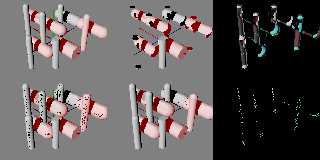
|
 |
|  |
|  |
|
 |
From: William F Pokorny
Subject: Re: Old media blob issue leading to a look at sturm / polysolve.
Date: 18 May 2018 13:10:55
Message: <5aff091f$1@news.povray.org>
|
|
 |
|  |
|  |
|
 |
On 05/18/2018 01:00 PM, William F Pokorny wrote:
> On 03/30/2018 08:21 AM, William F Pokorny wrote:
> ....
>
> Sturm / polysove() investigation. Those Difficult Coefficients.
>
I'll add quickly this set of updates fixes the remaining media speckles
for the scene which started this thread - see attached image. The
general media speckling issue is better with more accurate roots, but
not completely fixed.
Bill P.
Post a reply to this message
Attachments:
Download 'gailshawexampleclean.png' (167 KB)
Preview of image 'gailshawexampleclean.png'
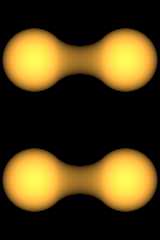
|
 |
|  |
|  |
|
 |
|
 |
|  |
|  |
|
 |
William F Pokorny <ano### [at] anonymous org> wrote:
> On 03/30/2018 08:21 AM, William F Pokorny wrote:
>
[snip]
> I've had the feeling for a while the code was probably doing nothing
> useful for us today. I was almost completely right. Close enough it's
> going into the bit bucket with this set of commits.
> ...
>
> The blobs were a different story. Many rays are being re-directed to
> sturm / polysolve for no benefit given the current solve_quartic code.
> To oblivion with that code you all say!
>
[snip]
Your detailed research into these arcane issues is really appreciated. I can't
say I understand some of it (most of it!), but we are all lucky to have your
keen eye probing the code. org> wrote:
> On 03/30/2018 08:21 AM, William F Pokorny wrote:
>
[snip]
> I've had the feeling for a while the code was probably doing nothing
> useful for us today. I was almost completely right. Close enough it's
> going into the bit bucket with this set of commits.
> ...
>
> The blobs were a different story. Many rays are being re-directed to
> sturm / polysolve for no benefit given the current solve_quartic code.
> To oblivion with that code you all say!
>
[snip]
Your detailed research into these arcane issues is really appreciated. I can't
say I understand some of it (most of it!), but we are all lucky to have your
keen eye probing the code.
Post a reply to this message
|
 |
|  |
|  |
|
 |
From: clipka
Subject: Re: Old media blob issue leading to a look at sturm / polysolve.
Date: 18 May 2018 22:16:31
Message: <5aff88ff@news.povray.org>
|
|
 |
|  |
|  |
|
 |
Am 18.05.2018 um 19:00 schrieb William F Pokorny:
> Chrisoph added this bit of code in blob.cpp to avoid visible seams:
>
> DBL depthTolerance = (ray.IsSubsurfaceRay()? 0 : DEPTH_TOLERANCE);
>
> I've been running with DEPTH_TOLERANCE at 1e-4 for a long time in my
> personal version of POV-Ray which fixes all the blob accuracy issues
> except for the subsurface one.
For subsurface rays it's safer to keep it at exactly 0.
The `depthTolerance` mechanism, to all of my knowledge, is in there to
make sure that transmitted, reflected or shadow rays don't pick up the
original surface again.
This problem is absent in rays earmarked as subsurface rays (presuming
we have high enough precision) because such rays are never shot directly
from the original intersection point, but a point translated slightly
into the object. So subsurface rays already carry an implicit
depthTolerance with them.
> It could be adjusted so as to push more solve_quartic rays into sturm /
> polysolve, but it's aleady the case most difficult-coefficient rays are
> unnecessarily run in sturm / polysolve when solve_quartic would work
> just fine. The right thing to do is let users decide when to use 'sturm'
> and this set of commit dumps the difficult_coeffs() code.
Would it make sense to, rather than ditching the test entirely, instead
have it trigger a warning after the render (akin to the isosurfaces
max_gradient info messages) informing the user that /if/ they are seeing
artifacts with the object they may want to turn on sturm (provided of
course sturm is off)?
Post a reply to this message
|
 |
|  |
|  |
|
 |
From: William F Pokorny
Subject: Re: Old media blob issue leading to a look at sturm / polysolve.
Date: 19 May 2018 09:49:07
Message: <5b002b53@news.povray.org>
|
|
 |
|  |
|  |
|
 |
On 05/18/2018 10:16 PM, clipka wrote:
> Am 18.05.2018 um 19:00 schrieb William F Pokorny:
>
>> Chrisoph added this bit of code in blob.cpp to avoid visible seams:
>>
>> DBL depthTolerance = (ray.IsSubsurfaceRay()? 0 : DEPTH_TOLERANCE);
>>
>> I've been running with DEPTH_TOLERANCE at 1e-4 for a long time in my
>> personal version of POV-Ray which fixes all the blob accuracy issues
>> except for the subsurface one.
Formally a blob's 'DEPTH_TOLERANCE' value was used for both the returned
from ray origin intersection tolerance and the internal
determine_influences() 'mind_dist' tolerances - though they control
different things. The internal sub-element influences mechanism now uses
>0.0. Should have always I believe except it does sometimes create
slightly more difficult ray-surface equations - which is my bet for why
the original v1.0 code didn't.
>
> For subsurface rays it's safer to keep it at exactly 0.
>
> The `depthTolerance` mechanism, to all of my knowledge, is in there to
> make sure that transmitted, reflected or shadow rays don't pick up the
> original surface again.
>
It depends about which intersection depth tolerance you speak. There are
variations of the mechanism.
a) What you say is close to my understanding for the continued and
shadow ray mechanisms which exists outside the code for each shape.
These mechanisms live in the 'ray tracing' code. I'd slightly reword
what you wrote to say these mechanisms prevent the use of ray - surface
intersections within some distance of a previous intersection. This
distance is today usually SMALL_TOLERANCE or 1e-3. SHADOW_TOLERANCE has
also been 1e-3 for more than 25 years and was only every something
different because Enzmann's initial solvers had a hard coded shadow ray
filter at a larger the SMALL_TOLERANCE value. There is too
MIN_ISECT_DEPTH.
b) Root / intersection depth tolerance filters exist in the code for
each shape/surface too. These control only whether all roots /
intersections for the shape are greater than a minimum intersection
depth relative to the incoming ray's origin or less than MAX_DISTANCE.
They do not control how closely ray surface intersections are spaced
from each other(1)(2). True the shape depth tolerance can influence
continued or shadow ray handling as seen by being 'different' than those
used in (a). However, we should aim for (b) <= (a) depth tolerance
alignment.
On seeing your subsurface code running the (b) variety at >0.0. I had
the thought, why not do this with all shapes / surfaces? Let (a) filter
the roots for its need. This would get us closer to a place where we'd
be able to make SMALL_TOLERANCE & MIN_ISECT_DEPTH smaller so people
don't have to so often do the ugly scale up their scene trick. There is
no numerical reason we cannot support generally much smaller scene
dimensions than we do.
Well it turns out returning all the roots >0.0 in each shapes (b)
mechanism costs cpu time - about 1% of a 3% increase with the internal
blob influence min_dist change for a glass blob scene. Time is saved
where intersections which (a) would have to filter later are just never
returned by (b). This experiment is why I set blob.cpp's DEPTH_TOLERANCE
= MIN_ISECT_DEPTH - which only happens also be the 1e-4 I've long been
using. I currently think the (b) depth for each shape / surface should
be migrated to MIN_ISECT_DEPTH over time.
(1) - I expect CSG generally needs all the roots regardless of spacing,
but this is code I've never reviewed.
(2) - Mostly true for what I've seen. But who knows, might be other
inbuilt shape, surface implementations do spacial root filtering for
internal reasons. The sphere_sweep's code seems to be doing a sort of a
root correction thing - with which you are far more familiar than me.
> This problem is absent in rays earmarked as subsurface rays (presuming
> we have high enough precision) because such rays are never shot directly
> from the original intersection point, but a point translated slightly
> into the object. So subsurface rays already carry an implicit
> depthTolerance with them.
>
I tested subsurface scenes with my updates and believe the changes are
compatible without the need for the returned depth to be >0.0. Thinking
about it another way, if the 'returned' min depth needed to be >0.0 for
subsurface to work, all shapes would need that conditional for >0.0 and
this is not the case. Believe we're good, but we can fix things if not.
>> It could be adjusted so as to push more solve_quartic rays into sturm /
>> polysolve, but it's aleady the case most difficult-coefficient rays are
>> unnecessarily run in sturm / polysolve when solve_quartic would work
>> just fine. The right thing to do is let users decide when to use 'sturm'
>> and this set of commit dumps the difficult_coeffs() code.
>
> Would it make sense to, rather than ditching the test entirely, instead
> have it trigger a warning after the render (akin to the isosurfaces
> max_gradient info messages) informing the user that /if/ they are seeing
> artifacts with the object they may want to turn on sturm (provided of
> course sturm is off)?
>
We should think about it, but currently I answer no to your specific
question. The difficult coefficient method is wildly inaccurate in
practice unlike the warning with isosurfaces.
A warning would be good if we can figure out something better... Mostly
it will be obvious - and more often obvious with this update. If running
blobs and you see speckles / noise - try sturm. Advice good today by the
way. Advice I should have taken with my own potential glow scene over
extreme AA - but the code dropped hid much of the solve_quartic issue
from me and I thought media the cause.
I ran test scenes where knowing you need sturm is pretty much impossible
to see without trying sturm and comparing images. For example, attached
is an image where I was aiming for a fruit looking thing with a faked
subsurface effect using multiple concentric blobs positive and negative
- taking advantage of blob's texture blending.
In the left column we see the <= master (3.8) current result where the
internal blob surfaces are not accurately resolved. The right column
shows the difference between column 1 and 2 for each row.
The top row, middle shows the new all solve_quartic() solution which in
fact has bad roots on a surface internal to the outer ones. Negative
blobs in addition to tiny thresholds tend to trip the solve_quartic
failures. We cannot 'see' we've got bad roots... The bottom row is the
accurate - though it happens less attractive - sturm result.
Reasonable accurate warnings would be good. Wonder if there is a way to
pick the issue up in solve_quartic itself or in blob.cpp knowing sturm
not set....
Bill P.
Post a reply to this message
Attachments:
Download 'diffcoeffhidden.png' (160 KB)
Preview of image 'diffcoeffhidden.png'
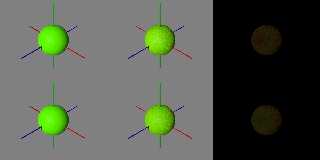
|
 |
|  |
|  |
|
 |
From: William F Pokorny
Subject: Re: Old media blob issue leading to a look at sturm / polysolve.
Date: 20 May 2018 12:10:08
Message: <5b019de0$1@news.povray.org>
|
|
 |
|  |
|  |
|
 |
On 05/18/2018 10:16 PM, clipka wrote:
> Am 18.05.2018 um 19:00 schrieb William F Pokorny:
>
>> Chrisoph added this bit of code in blob.cpp to avoid visible seams:
>>
>> DBL depthTolerance = (ray.IsSubsurfaceRay()? 0 : DEPTH_TOLERANCE);
>>
>> I've been running with DEPTH_TOLERANCE at 1e-4 for a long time in my
>> personal version of POV-Ray which fixes all the blob accuracy issues
>> except for the subsurface one.
>
> For subsurface rays it's safer to keep it at exactly 0.
>
...
>
> This problem is absent in rays earmarked as subsurface rays (presuming
> we have high enough precision) because such rays are never shot directly
> from the original intersection point, but a point translated slightly
> into the object. So subsurface rays already carry an implicit
> depthTolerance with them.
>
Aside: 'exactly 0' unless we change blob.cpp code means >0.0.
I woke up this morning thinking more about your description of SSLT and
though I picked up no major differences in result, results were not
identical - but I didn't expect them to be. I'd not run the returned
root depth threshold at both 0.0 and 1e-4 (MIN_ISECT_DEPTH) and compared
results.
The top row in the attached image is without sturm the bottom with. The
differences are very subtle, but can be seen after being multiplied by 50.
The left column is less my recent changes so min_dist and the return
depth >0.0 with sturm automatically getting used often in the upper left
image.
The middle column is the updated code so the middle top now using
strictly solve_quartic() making the differences on the right are
greater. The bottom, sturm always row best shows the effect of not
returning roots <= 1e-4 from the ray origin.
My position is still the difference isn't large enough to be of concern,
but if so, maybe we should more strongly consider going to >0.0 or some
very small values for all shapes. Doing it only in blob.cpp doesn't make
sense to me.
Aside: MIN_ISECT_DEPTH doesn't exist before 3.7. Is it's creation
related to the SSLT implementation?
Bill P.
Post a reply to this message
Attachments:
Download 'sslt_rtrnrootquestion.png' (460 KB)
Preview of image 'sslt_rtrnrootquestion.png'
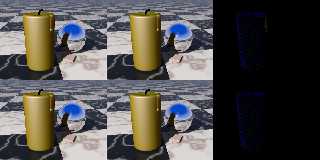
|
 |
|  |
|  |
|
 |
From: clipka
Subject: Re: Old media blob issue leading to a look at sturm / polysolve.
Date: 20 May 2018 17:09:35
Message: <5b01e40f$1@news.povray.org>
|
|
 |
|  |
|  |
|
 |
Am 20.05.2018 um 18:10 schrieb William F Pokorny:
> My position is still the difference isn't large enough to be of concern,
> but if so, maybe we should more strongly consider going to >0.0 or some
> very small values for all shapes. Doing it only in blob.cpp doesn't make
> sense to me.
I guess the reason I changed it only for blobs was because there I
identified it as a problem - and I might not have been familiar enough
with the shapes stuff to know that the other shapes have a similar
mechanism.
After all, why would one expect such a mechanism if there's the "global"
MIN_ISECT_DEPTH?
Technically, I'm pretty sure the mechanism should be disabled for SSLT
rays in all shapes.
> Aside: MIN_ISECT_DEPTH doesn't exist before 3.7. Is it's creation
> related to the SSLT implementation?
No, it was already there before I joined the team. The only relation to
SSLT is that it gets in the way there.
My best guess would be that someone tried to pull the DEPTH_TOLERANCE
mechanism out of all the shapes, and stopped with the work half-finished.
BTW, one thing that has been bugging me all along about the
DEPTH_TOLERANCE and MIN_ISECT_DEPTH mechanisms (and other near-zero
tests in POV-Ray) is that they're using absolute values, rather than
adapting to the overall scale of stuff. That should be possible, right?
Post a reply to this message
|
 |
|  |
|  |
|
 |
|
 |
|  |
|
 |




![]()